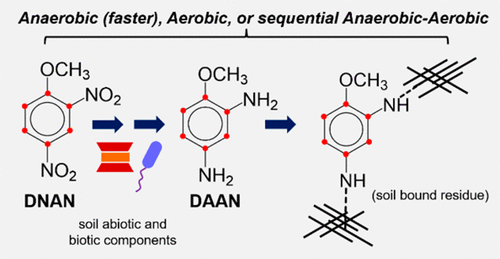当前位置:
X-MOL 学术
›
Environ. Sci. Technol.
›
论文详情
Our official English website, www.x-mol.net, welcomes your feedback! (Note: you will need to create a separate account there.)
Environmental Fate of 14C Radiolabeled 2,4-Dinitroanisole in Soil Microcosms
Environmental Science & Technology ( IF 11.4 ) Pub Date : 2017-11-06 00:00:00 , DOI: 10.1021/acs.est.7b03699 Christopher I. Olivares 1 , Camila L. Madeira 1 , Reyes Sierra-Alvarez 1 , Warren Kadoya 1 , Leif Abrell 1 , Jon Chorover 1 , Jim A. Field 1
Environmental Science & Technology ( IF 11.4 ) Pub Date : 2017-11-06 00:00:00 , DOI: 10.1021/acs.est.7b03699 Christopher I. Olivares 1 , Camila L. Madeira 1 , Reyes Sierra-Alvarez 1 , Warren Kadoya 1 , Leif Abrell 1 , Jon Chorover 1 , Jim A. Field 1
Affiliation

|
2,4-Dinitrosanisole (DNAN) is an insensitive munitions component replacing conventional explosives. While DNAN is known to biotransform in soils to aromatic amines and azo-dimers, it is seldom mineralized by indigenous soil bacteria. Incorporation of DNAN biotransformation products into soil as humus-bound material could serve as a plausible remediation strategy. The present work studied biotransformation of DNAN in soil and sludge microcosms supplemented with uniformly ring-labeled 14C-DNAN to quantify the distribution of label in soil, aqueous, and gaseous phases. Electron donor amendments, different redox conditions (anaerobic, aerobic, sequential anaerobic–aerobic), and the extracellular oxidoreductase enzyme horseradish peroxidase (HRP) were evaluated to maximize incorporation of DNAN biotransformation products into the nonextractable soil humus fraction, humin. Irreversible humin incorporation of 14C-DNAN occurred at higher rates in anaerobic conditions, with a moderate increase when pyruvate was added. Additionally, a single dose of HRP resulted in an instantaneous increased incorporation of 14C-DNAN into the humin fraction. 14C-DNAN incorporation to the humin fraction was strongly correlated (R2 = 0.93) by the soil organic carbon (OC) amount present (either intrinsic or amended). Globally, our results suggest that DNAN biotransformation products can be irreversibly bound to humin in soils as a remediation strategy, which can be enhanced by adding soil OC.
中文翻译:

土壤微观世界中14 C放射性标记的2,4-二硝基苯甲醚的环境命运
2,4-二硝基茴香醚(DNAN)是一种不敏感的弹药成分,可替代常规炸药。虽然已知DNAN可在土壤中生物转化为芳香胺和偶氮二聚体,但很少会被本地土壤细菌矿化。将DNAN生物转化产物作为结合腐殖质的物质掺入土壤中可以作为合理的补救策略。本工作研究了在土壤和污泥微观世界中DNAN的生物转化,并补充了均匀环标记的14C-DNAN用于定量标记在土壤,水相和气相中的分布。对电子供体的修正,不同的氧化还原条件(厌氧,好氧,顺序厌氧-好氧)和细胞外氧化还原酶辣根过氧化物酶(HRP)进行了评估,以最大程度地将DNAN生物转化产物掺入不可提取的土壤腐殖质级分-腐殖质中。在厌氧条件下,较高浓度下的14 C-DNAN不可逆腐殖质掺入率较高,当添加丙酮酸盐时,适度增加。另外,单剂量的HRP导致瞬时增加的14 C-DNAN掺入腐殖质级分。14 C-DNAN掺入到人的腐殖质中有很强的相关性(R 2= 0.93)取决于土壤中存在的有机碳(OC)量(固有的或修正的)。在全球范围内,我们的研究结果表明,DNAN生物转化产物可以不可逆地与土壤中的腐殖质结合,作为一种修复策略,可以通过添加土壤OC来增强。
更新日期:2017-11-07
中文翻译:

土壤微观世界中14 C放射性标记的2,4-二硝基苯甲醚的环境命运
2,4-二硝基茴香醚(DNAN)是一种不敏感的弹药成分,可替代常规炸药。虽然已知DNAN可在土壤中生物转化为芳香胺和偶氮二聚体,但很少会被本地土壤细菌矿化。将DNAN生物转化产物作为结合腐殖质的物质掺入土壤中可以作为合理的补救策略。本工作研究了在土壤和污泥微观世界中DNAN的生物转化,并补充了均匀环标记的14C-DNAN用于定量标记在土壤,水相和气相中的分布。对电子供体的修正,不同的氧化还原条件(厌氧,好氧,顺序厌氧-好氧)和细胞外氧化还原酶辣根过氧化物酶(HRP)进行了评估,以最大程度地将DNAN生物转化产物掺入不可提取的土壤腐殖质级分-腐殖质中。在厌氧条件下,较高浓度下的14 C-DNAN不可逆腐殖质掺入率较高,当添加丙酮酸盐时,适度增加。另外,单剂量的HRP导致瞬时增加的14 C-DNAN掺入腐殖质级分。14 C-DNAN掺入到人的腐殖质中有很强的相关性(R 2= 0.93)取决于土壤中存在的有机碳(OC)量(固有的或修正的)。在全球范围内,我们的研究结果表明,DNAN生物转化产物可以不可逆地与土壤中的腐殖质结合,作为一种修复策略,可以通过添加土壤OC来增强。



























 京公网安备 11010802027423号
京公网安备 11010802027423号